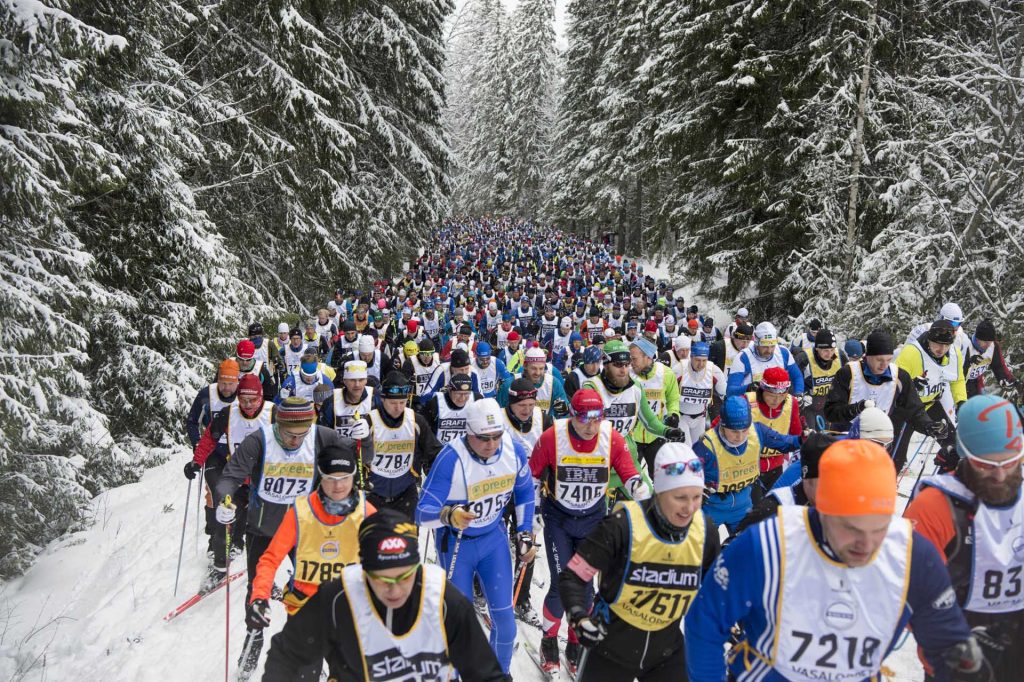Vasaloppet
Take on the challenge of the world’s biggest cross-country ski race.
It’s a long-standing tradition; hundreds of thousands of skiers have made their way along the Vasaloppet track since 1922. Elite and recreational athletes ski together, starting in Berga by in Sälen and going 90 kilometres down to the classic finish line portal in Mora to the cheers of the crowd. The style is classic, and the nature experience is magical. The race is followed by millions of TV viewers in multiple countries. Now it’s your turn to take on the challenge! You may participate from the year you turn 17.
Vasaloppet 2026
- DateMarch 01
- Start Time08:00
- Length90 km
- Start LocationSälen
- TechniqueClassic technique
- AgeFrom 17 years
- ClassWomen, Men
- TypeCompetition
- Order Number102
- Included inEn Svensk Klassiker, Vasaloppstrippeln 90
- Training grants102 000 SEK to the female and male winner
-
Course profile


Registration fee
From 17 years
Welcome to Vasaloppet
Your race day begins in Berga by, Sälen. You collect your number bib in Mora or Sälen, either in the days before or at the start before setting off. There will be plenty of people and traffic, so make sure to allow ample time to reach the start! Once there, you hand in your bag with a change of clothes at the correct lorry – which will safely transport your bag to the finish.
Vasaloppet has both a women’s and a men’s class. The joint start is at 08:00. The start pens for group 10 open at 05:00, and for start groups 1–9 at 05:30. You must be in your start group no later than 07:45.
Over the 90 kilometres to the finish in Mora, you pass seven checkpoints. Here, you can replenish your energy and drinks and get ski wax assistance. Toilets and medical staff are available at all checkpoints.
You have about 12 hours to reach the finish, and at each checkpoint, there’s a cut-off time – the latest permitted passage. The basic rule on the track is: Keep to the right, overtake on the left.
As you approach Mora and catch sight of the church tower, you’ll know the home stretch is near. That’s the moment to prepare for your finish – remember to enjoy gliding under the historic finish portal. After finishing, you’ll receive your well-earned medal and be offered drinks and refreshments. You can leave your skis in the ski deposit and take the free bus to the showers at Prästholmens IP, where your bag will be waiting. Afterwards, you can return to the finish area to collect your diploma and skis and continue celebrating with all the other skiers.
Every finish is a victory. See you on the track!
Hosts

More information about the race
In Vasaloppet you can affect which group you start in by skiing a so called seeding race. After showing your mettle in such a race you will be placed in an appropriate start group.
Read more about seeding
All participants must wear a number bib and timing chip.
These are collected at the race office at the start in Sälen or on Kyrkogatan (the pedestrian street) in Mora prior to the race.
Start kits that are not collected the day before the race will be at the race office at your start location.
Our opening hours
Joint start at 08.00.
Entrance to start group 10 opens at 05.00. Entrance to the start group 1–9 open at 05.30. You must be in place at your start group no later than 07.45.
Entrance to startgroup Elite opens 06.30. You must be in place at your start group no later than 07.30.
If you are seeded your seeding is registered in the data chip which is read at the entrance to the start group.
Along the Vasaloppet course there are seven official checkpoints: Smågan, Mångsbodarna, Risberg, Evertsberg, Oxberg, Hökberg and Eldris.
Drink and energy in various forms is served at all checkpoints. Specifics on what is served can be found on the detailed race map. At the checkpoints we offer grip wax services as well as minor equipment repairs. There are toilets and medical services at all checkpoints, as well as at the start and finish.
Detailed race map (pdf)
Ingredients served products (pdf)
For your security there are restrictions at some checkpoints; time limits after which you cannot pass. The checkpoint must be left 10 minutes after the time limit for arrival has expired.
If you arrive too late at a checkpoint you must abort the race. Bus transport to the finish in Mora will then be arranged.
If you reach the checkpoints within the time limits, you will be able to complete the race.
In extreme weather conditions the race directors have the right to change the time limits.
| Checkpoint | Time limit |
|---|---|
| Smågan | 10.30 |
| Mångsbodarna | 12.15 |
| Risberg | 13.45 |
| Evertsberg | 15.00 |
| Oxberg | 16.30 |
| Hökberg | 17.40 |
| Eldris | 19.00 |
Sometimes things don’t go as planned. It’s completely okay not to finish.
Contact medical staff or an official at the nearest checkpoint. They will help you with taking care of your timing chip, reporting your withdrawal and arranging transport to the finish in Mora.
Safety first:
Rescue and medical personnel have the right to remove participants from the course if they deem it necessary.
Your safety always comes before finishing the race.
The race has two classes: Women och Men.
Participation medals are awarded to all finishers directly after the finish line.
Placement medals – gold, silver and bronze – will be awarded to the first, second and third placed participant in men’s respectively women’s class.
If you complete the race at the winning time plus 50 percent (in ladies’ or men’s class) you will be awarded Vasaloppet’s achievement medal directly after the finish.
The awards ceremony takes place at Mora-Nisse’s Square in the finish area in Mora at 15.00.
Classic technique.
Any use of free technique leads to disqualification. International Ski Federation (FIS) competition rules apply. Read the rules in their entirety at FIS’s website.
Read more about our rules and visit our Guides and Tips.
Guides and tips
On the page Guides and tips, you’ll find everything from training programs to practical details about buses, accommodation and waxing services – in short, everything you need to know before your race.




